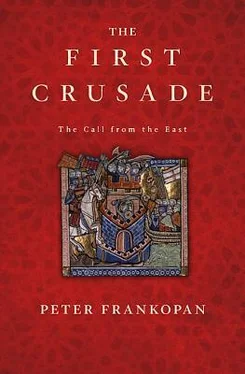However, this does not mean that the text is a falsification. As we have seen, there were many westerners living in Constantinople in the late eleventh century, including a number who were close to the emperor. As such, both the tone and ideas expressed in the letter could just as easily represent the hand of a foreigner writing in the imperial capital, as that of an author writing after the First Crusade. And in this respect, what is perhaps most striking about the letter is that almost everything it says tallies with the new picture of Asia Minor that can be established from other contemporary sources. The letter to Robert of Flanders also reports desecration of churches in the early 1090s that we know about from elsewhere: ‘The holy places are desecrated and destroyed in countless ways and the threat of worse looms over them. Who cannot lament over these things? Who has no compassion when they hear of it? Who cannot be horrified? And who cannot turn to prayer?’ 21The letter contains accounts of the ferocity of the Turkish attacks which likewise find parallels with other sources from this period, albeit in more detail: ‘Noble matrons and their daughters, robbed of everything, are violated, one after another, like animals. Some [of their attackers] shamelessly place virgins in front of their own mothers and force them to sing wicked and obscene songs until they have finished having their way with them ... men of every age and description, boys, youths, old men, nobles, peasants and what is worse still and yet more distressing, clerics and monks and woe of unprecedented woes, even bishops are defiled with the sin of sodomy and it is now trumpeted abroad that one bishop has succumbed to this abominable sin.’ 22
It certainly made sense for Alexios to appeal to Flanders, having already received military support in the form of 500 knights shortly beforehand. Alexios hoped to attract further assistance from Count Robert, a man of similar character to himself – ascetic, pious and pragmatic. And while the desperate descriptions of the situation in the east have been dismissed by many as implausible, there is much to suggest that the letter genuinely reflects Byzantium’s dire position. Even the downbeat statement that ‘although I am emperor, I can find no remedy or suitable counsel, but am always fleeing in the face of the Pechenegs and the Turks’, is not out of place at a time when one of the highest clerics in the empire could state publicly that God had abandoned Alexios. 23The siege mentality that had begun to emerge in Constantinople strikes a closer chord with the letter than often presumed.
The recall of the Flemish garrison from Nikomedia may not have been solely responsible for the loss of the town to the Turks, but it certainly did not help. Soon after the defeat of the Pechenegs in 1091 a major effort was made to recover the town and to drive the Turks back from the areas closest to the capital. Assembling a substantial force, Alexios sent in an army which recovered territory as far as the Arm of St George, that is to say up to the Gulf of Nikomedia. Eventually the town itself was recaptured, with its conquerors immediately setting about restoring its defences to prevent it falling so easily in the future. A fortress was constructed opposite Nikomedia, designed in the first instance to provide additional protection for the town, but also built to act as a base from which to attack if it did fall to the Turks once again. In addition, grandiose work began on the creation of a giant ditch to act as a further barrier to defend Nikomedia. It was a sign of desperation and an indication of the limitations of Byzantine ambitions in Asia Minor in the early 1070s: rather than reconquest, attention was focused on retaining the few possessions still in imperial hands. 24
A full six months were spent reinforcing the town. In the meantime, attempts were made to persuade its inhabitants to leave the ‘caves and hollows of the earth’ which they had escaped to during Abu’l-Kasim’s attack and return to Nikomedia. Their reluctance to return would suggest that many thought that the Byzantine recovery may not be permanent. 25
While Nikomedia had been recovered, the situation worsened on the western coast and the islands in the Aegean. Once again, the chronology provided by the Alexiad is untrustworthy. A corpus of documents relating to a monk named St Christodoulos reveals the true escalation of the threat posed by the Turks. Christodoulos was a magnetic character with friends in high places. Alexios’ mother, Anna Dalassene, helped the monk secure land grants and tax exemptions for properties on the Aegean islands of Kos, Leros and Lipsos where Christodoulos had ambitious plans to build a series of monasteries. Anna’s support was instrumental in convincing the emperor to give his personal approval for the establishment of the monastery of St John on the island of Patmos in 1088. 26
At the start of the 1090s, however, physical survival – rather than grants or tax exemptions – had become the main concern for Christodoulos and the monks on these islands. Attacks by Turkish pirates and raiders forced them to take urgent steps to reinforce their settlements. On Patmos, Leros and Lipsos, small castles were built in an attempt to protect the communities, but it soon became clear that Christodoulos was fighting an uphill battle. 27The monks fled, in fear of being captured by the Turks, and in the spring of 1092 Christodoulos himself gave up, escaping to Euboea where he died a year later. As a codicil to his will reveals, written shortly before his death, he was the last to leave Patmos; relentless attacks by ‘Agarenes, pirates and Turks’ had made life impossible. 28
There was little improvement in the situation in the Aegean or the western coast of Asia Minor in the years that followed. Although Anna Komnene belittled Çaka, mocking him as a poseur who strutted about Smyrna wearing sandals styled on those of the emperor, and implying that he was easily and quickly dealt with, the truth was very different. 29In 1094, Theodore Kastrisios, who had been appointed caretaker of the monastery of St John on Patmos following the death of Christodoulos, felt he had no option but to resign his position. He did so, he said, because he was unable to fulfil any of his duties: constant Turkish raids in the eastern Aegean meant that he could not even reach the island, let alone look after the monastery. 30
The near total collapse of Asia Minor was rapid and spectacular. While the Pecheneg threat had played an important role in creating opportunities for individual Turkish leaders, such as Abu’l-Kasim and Çaka, it was the failure of Alexios’ previous policy of forging local alliances that lay at the heart of the problems now facing Byzantium. In the past, Alexios had been able to win over Turkish warlords and had backed this up with an effective agreement with the sultan of Baghdad, who had his own interests in maintaining control over emirs on the periphery of the Seljuk world.
This alliance with Malik-Shah was still active in the spring of 1091, when Alexios complained that reinforcements sent to him by the sultan were being diverted and recruited by Çaka. 31Malik-Shah was also perturbed by the dramatic shift in power, and in the summer of 1092, sent a major expedition under the command of one his most loyal officers, Buzan, deep into Asia Minor to teach Abu’l-Kasim a lesson. Although Buzan advanced decisively on Nicaea, he was unable to make an impression on the town’s formidable defences and eventually withdrew. 32Nevertheless, diplomatic exchanges between Constantinople and Baghdad were still ongoing in the autumn of that year, continuing to explore how the two rulers could best co-operate against Abu’l-Kasim and other renegades in the region. 33
The death of Malik-Shah in November 1092 therefore served as a body blow for Alexios’ policy in the east. In the months before he died, the sultan found his grip on power weakening as rivals in Baghdad jockeyed for position. In an attempt to consolidate his authority, MalikShah demoted many of his leading officers, which only stoked dissent further. 34Antagonism focused on the sultan’s vizier, the polymath Nizam al-Mulk, a powerful figure who had played a fundamental role in shaping the Seljuk world in the later eleventh century. Towards the end of 1092 he was disposed of, murdered by a secretive sect of fanatics known as the Assassins, if not on the direct instructions of the sultan, then at least with his knowledge, according to one well-informed source. 35The death of Malik-Shah just a few weeks later – after eating contaminated meat – threw the Turkish world into turmoil, as uncertainty raged as to who amongst the sultan’s immediate and extended family would succeed to the throne. The result was two years of almost constant civil war. 36
Читать дальше











